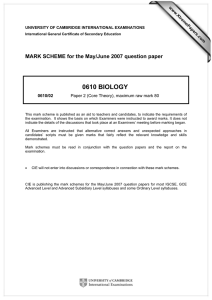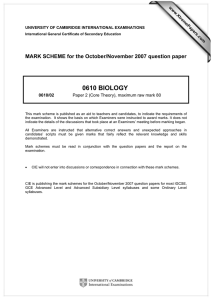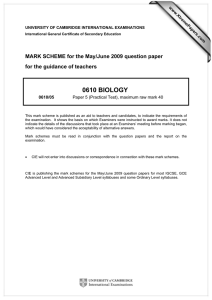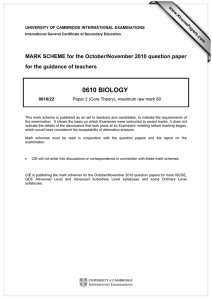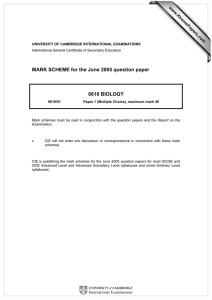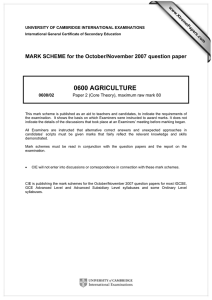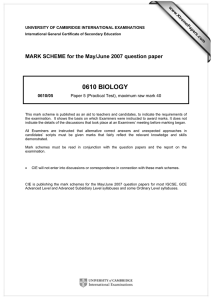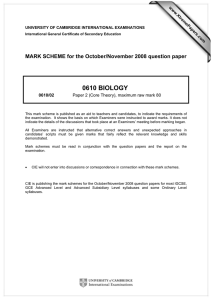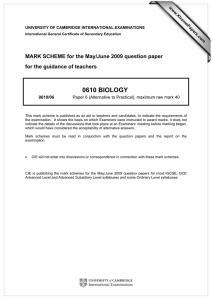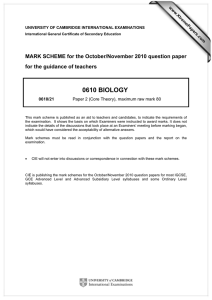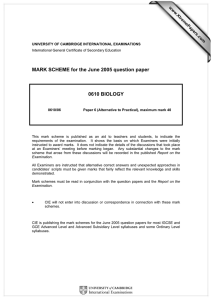0610 BIOLOGY MARK SCHEME for the May/June 2010 question paper
advertisement
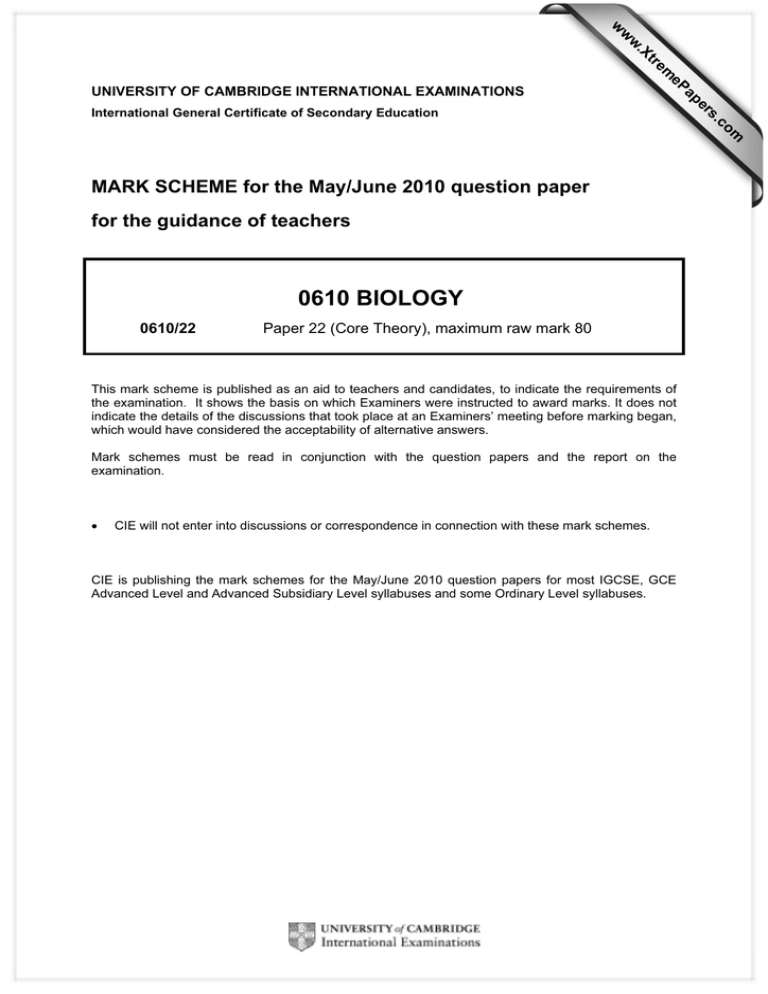
w w ap eP m e tr .X w UNIVERSITY OF CAMBRIDGE INTERNATIONAL EXAMINATIONS for the guidance of teachers 0610 BIOLOGY 0610/22 Paper 22 (Core Theory), maximum raw mark 80 This mark scheme is published as an aid to teachers and candidates, to indicate the requirements of the examination. It shows the basis on which Examiners were instructed to award marks. It does not indicate the details of the discussions that took place at an Examiners’ meeting before marking began, which would have considered the acceptability of alternative answers. Mark schemes must be read in conjunction with the question papers and the report on the examination. • CIE will not enter into discussions or correspondence in connection with these mark schemes. CIE is publishing the mark schemes for the May/June 2010 question papers for most IGCSE, GCE Advanced Level and Advanced Subsidiary Level syllabuses and some Ordinary Level syllabuses. om .c MARK SCHEME for the May/June 2010 question paper s er International General Certificate of Secondary Education Page 2 Mark Scheme: Teachers’ version IGCSE – May/June 2010 Syllabus 0610 Paper 22 General notes Do not exceed the section sub-totals or question maxima. Symbols used in mark scheme and guidance notes. / separates alternatives for a marking point ; separates points for the award of a mark MP mark point - used in guidance notes when referring to numbered marking points ORA or reverse argument / reasoning OWTTE or words to that effect A accept - as a correct response R reject – this is marked with a cross and any following correct statements do not gain any marks I ignore / irrelevant / inadequate – this response gains no mark, but any following correct answers can gain marks. ( ) the word / phrase in brackets is not required to gain marks but sets the context of the response for credit. e.g. (waxy) cuticle. Waxy not needed but if it was described as a cellulose cuticle then no mark is awarded. mitosis underlined words – this word only e.c.f. error carried forward © UCLES 2010 Page 3 Mark Scheme: Teachers’ version IGCSE – May/June 2010 Syllabus 0610 Paper 22 1 A B C D E 1a 1b 2a 2b 3a 3b 4a 4b any four correct rows, ticks + name, 1 mark each If all five names are correct but no ticks in grid MAX 2 A – yes for a tick R – other ticks in any row I – crosses/no in other boxes name Venerupis; Turritella; Patella; Cardium; Buccinum; [4] [Total: 4] © UCLES 2010 Page 4 2 Mark Scheme: Teachers’ version IGCSE – May/June 2010 (a) (i) to form /harden bones/teeth/enamel; (ii) to form haemoglobin; (b) (i) to form chlorophyll; (ii) to form amino acids/proteins; (c) Syllabus 0610 [1] A – become stronger/strengthen A – clotting of blood [1] A – myoglobin/enzymes/electron carriers [1] A – ref. to chloroplast [1] DO NOT award points that are radically out of logical order I – omissions from sequence 1 increased algal/aquatic plant growth/algal bloom; 2 3 4 5 6 7 8 Paper 22 cover surface of water; cut off light below water so plants die; dead plants decompose/fed on by bacteria; bacteria reproduce/multiply; use up oxygen/respire aerobically/water becomes anaerobic; animals in river die/migrate; correct ref. to eutrophication; any four – 1 mark each [4] [Total: 8] © UCLES 2010 Page 5 3 Mark Scheme: Teachers’ version IGCSE – May/June 2010 Syllabus 0610 Paper 22 (a) blue – because no white flowers in offspring/in presence of inherited blue allele/OWTTE; [1] (b) R – Bb A – ecf from (a) (i) blue – BB; white – bb; [2] (ii) offspring – Bb; [1] (iii) 1 parents Bb 2 gametes B 3 offspring genotypes 4 phenotypes Bb blue, 5 ratio any four – 1 mark each (c) x b b b; Bb bb blue, If parent genotypes wrong then allow e.c.f. for MPs 2 and 3 only bb; bb; white, white; 2 : 2/1 : 1; [4] (i) shows extremes and all intermediates (of cob length); [1] A – sun A – ref. to named mineral/nutrients A – rain I – humidity A – ref. to disease/damage by pest (ii) 1 (amount of) light; 2 (amount of) minerals; 3 (amount of) water; 4 temperature; any three – 1 mark each [3] (ii) flower colour only blue or white/no intermediate colours (thus is discontinuous variation); [1] [Total: 13] © UCLES 2010 Page 6 4 Mark Scheme: Teachers’ version IGCSE – May/June 2010 Syllabus 0610 Paper 22 (a) (arctic) plants lemmings (snowy) owl; [1] (b) (i) increasing numbers of lemmings reproducing; [1] A – snowy owl population/predators are decreasing (ii) 1 lemming population too large for food supply/OWTTE; 2 snowy owl population increasing; 3 thus more predation/more lemmings eaten; any two – 1 mark each [2] (iii) 1 2 3 as lemming population falls/rises so does the snowy owl population; but with a time delay; because of less/more food for the snowy owls; [3] (iv) 1 2 3 4 lemming population would increase/reach a peak; because of less predation; (after peak) levels off / falls; equilibrium with plants/food/other factors coming into play/ OWTTE; 5 too many lemmings for food supply to support/OWTTE: any three – 1 mark each [3] I – light (c) (i) the sun; [1] (ii) photosynthesis; [1] [Total: 12] © UCLES 2010 Page 7 5 (a) (b) Mark Scheme: Teachers’ version IGCSE – May/June 2010 Syllabus 0610 Paper 22 (i) 184; [1] (ii) liver; [1] (iii) line meets/cuts horizontal axis at 4 pm; [1] +/- 1 grid square (iv) 10 am (approx); [1] A – response matching candidate’s graph line (i) 1 slows down nerve impulses/crossing synapses; 2 responses/reactions take longer; 3 interferes with judgements; any two – 1 mark each A – thinking impaired [2] A – can cause addiction (ii) 1 liver – causes cirrhosis/cancer/kills/destroys cells; 2 brain – damages/kills/destroys cells; A – nephrons/tubules 3 stomach – irritates/damages wall/lining of/cause ulcers; 4 kidney – can cause damage to cells; A – heart attack/CVD 5 heart – increased risk of coronary disease; any two – 1 mark each [2] (iii) 1 aggressive behaviour/fighting; 2 family break up/loss of friends; 3 inability to concentrate/poor time keeping – loss of job; 4 financial problems/money spent on alcohol; 5 lack of personal care/hygiene; 6 problems with law/theft; 7 drunk driving/higher risk of accidents/lose licence; 8 homelessness; any two – 1 mark each A – ref. to self harm [2] [Total: 10] © UCLES 2010 Page 8 6 Mark Scheme: Teachers’ version IGCSE – May/June 2010 Syllabus 0610 (a) formation of new individuals; involving one parent/no involvement of gametes/no fertilisation; Paper 22 reproduction is not credit worthy [2] A – part of parent plant forms new offspring (b) [1] R if response has a “t” (e.g. meiotsis) A – reduction division (ii) 1 all the offspring would be identical type/same variety/ A ref. to clones flavour of fruit; 2 increase in numbers quicker; any one – 1 mark [1] (i) meiosis; (c) 1 very visible/stand out/attract insects; 2 who are attracted for nectar/pollen/food; 3 (accidentally) collect/carry pollen on body; 4 brings about pollination; any three – 1 mark each A – leads to fertilisation/seed formation [3] (d) 1 colour attracts mammals/birds/animals/named example; 2 which eat fleshy part whole fruit; 3 and disperse seeds/OWTTE; any two – 1 mark each R – insects [2] [Total: 9] © UCLES 2010 Page 9 7 (a) Mark Scheme: Teachers’ version IGCSE – May/June 2010 (i) homeostasis; Syllabus 0610 Paper 22 [1] I – specific examples (ii) 1 2 3 4 allows constant metabolic rate/OWTTE; A – gives optimum temperature for enzymes allows enzymes to work (at constant rate); reduces risk of denaturing/destroying them; mammal independent of external temperature/can function in wide range of environments/OWTTE; any two – 1 mark each [2] (b) (i) 37.4; [1] (ii) widening of/relaxing of blood vessels/arterioles/muscles in A – capillaries are widened arterioles; [1] (iii) X placed on any point along downward curve; [1] A – just before peak (iv) 1 vasodilation allows more blood to flow; 2 through surface capillaries/blood vessels; 3 more heat loss occurs; 4 by radiation; 5 by convection; 6 so body temperature falls; any four – 1 mark each [4] [Total: 10] © UCLES 2010 Page 10 8 (a) Mark Scheme: Teachers’ version IGCSE – May/June 2010 Syllabus 0610 (i) liver; [1] (ii) gall bladder; [1] (iii) pancreas; [1] (b) 1 bile (salts) emulsify fats/oils; 2 increasing their surface area; 3 creates alkaline environment/raises pH; 4 lipase breaks down fat (molecules); 5 changing them to fatty acids and glycerol; any three – 1 mark each [3] [Total: 6] © UCLES 2010 Paper 22 Page 11 9 (a) Mark Scheme: Teachers’ version IGCSE – May/June 2010 (i) oxygen/dust/particles; (ii) carbon dioxide; water (vapour); (iii) lower; (b) mix air with/bubble through lime water; which goes cloudy/white/milky; Syllabus 0610 Paper 22 A – formula for oxygen [1] A – pollen I – ref to bacteria A – formulae for carbon dioxide and water [2] A – in either order I – ref to bacteria [1] A – cooler/colder A – hydrogencarbonate/bicarbonate indicator [2] A – goes yellow/golden/orange (c) 1 2 3 (diffusion is) random movement; A – gases of particles/molecules/ions; from their high concentration to their lower concentration/ R – along/across concentration gradient down concentration gradient; any two – 1 mark each [2] [Total: 8] © UCLES 2010

